0. SQL로 데이터 합치기
- 데이터는 총 5개의 csv 파일로 나누어져 있다.
- 우선 각 파일을 아래의 SQL조건으로 합쳤다.
select
d1.*,
d2.aisle_id, d2.department_id,
d3.department,
d4.aisle,
d5.order_number, d5.order_dow, d5.order_hour_of_day,
d5.days_since_prior_order, d5.eval_set
from
test.order_products as d1
inner join test.products as d2
on d1.product_id = d2.product_id
inner join test.departments as d3
on d2.department_id = d3.department_id
inner join test.aisles as d4
on d2.aisle_id = d4.aisle_id
inner join test.orders as d5
on d5.order_id = d1.order_id;- 데이터에서 재품 이름을 가뎌오지 않았다.
- 총 13개의 variable이 만들어졌다.
- inner join 을 했을시 데이터 길이가 1,048,576에서 422,287이 되었다.
1. 데이터 분석의 목적과 방향성
-
데이터 분석의 목표
Instacart 온라인 마켓에 식료품 아이탬에 따른 재주문 여부를 예측하는 것이다.
-
변수값 설명
현재 데이터엔 13개의 variable 이 있다.
Y variable은 'reordered' 이고 bionary scale 이다.
나머지 12개의 variable은 X variable로 둔다.
add_to_cart_order 는 정확한 정보는 없지만 cart에 들어있는 아이템 계수로 보인다.
order_id는 주문 index다.
product_id는 제품 종류에 따른 번호이다 각 품목에 대한 이름을 id로 표시해 놓았다.
aisle_id 는 제품이 display되어있는 색션으로 134개의 level이 있다.
aisle는 색션의 이름 정보이다.
department_id 는 식료품의 종류로 21개의 level이 있다.
department는 식료품 종류에 대한 str정보이다.(마찬가지로 21개의 level이 있다.
order_hour_of_day 는 주문 시간 정보이다.
days_since_prior_order 는 재주문을 하는데 걸린 시간이다. 0~30이 있다.
order_dow 는 주문 요일로 0~6의 인덱스로 되어있고 어느 요일이 어떻게 인덱싱 되었는지는 모른다.
2. EDA Setting
2.1 Library 불러오기
import pandas as pd
import numpy as np
import matplotlib.pyplot as plt
import seaborn as snssns.set_theme(style='whitegrid')
sns.set_palette("twilight")2.2 데이터 불러오기
from google.colab import files
myfile = files.upload()import iotrain = pd.read_csv('mydata.csv')type(train)pandas.core.frame.DataFrame
train.head()
train.info()
## No NULL value in the data<class 'pandas.core.frame.DataFrame'>
RangeIndex: 422286 entries, 0 to 422285
Data columns (total 13 columns):
# Column Non-Null Count Dtype
--- ------ -------------- -----
0 order_id 422286 non-null int64
1 product_id 422286 non-null int64
2 add_to_cart_order 422286 non-null int64
3 reordered 422286 non-null int64
4 aisle_id 422286 non-null int64
5 department_id 422286 non-null int64
6 department 422286 non-null object
7 aisle 422286 non-null object
8 order_number 422286 non-null int64
9 order_dow 422286 non-null int64
10 order_hour_of_day 422286 non-null int64
11 days_since_prior_order 422286 non-null int64
12 eval_set 422286 non-null object
dtypes: int64(10), object(3)
memory usage: 41.9+ MB
train.describe(include='all')3. EDA
3.1 Department id의 재주문
- 현재 Instacart에서 원하는 정보는 Product에 따른 재구메 정보이다.
- Department는 Product를 그룹별로 묶어놓은 것이다.
- Department id는 21개의 level로 되어있다.
# barplot of reordered by department_id
plt.figure(figsize=(12,12))
dep_bar = sns.barplot(x='department_id',
y='reordered',
data=train)
# xlab and ylab
dep_bar.set_xlabel('Department ID', fontsize=13)
dep_bar.set_ylabel('Percentage of Reordered', fontsize=13)
dep_bar.set_title('Barplot of Reordered by Department ID', fontsize=16)
plt.show()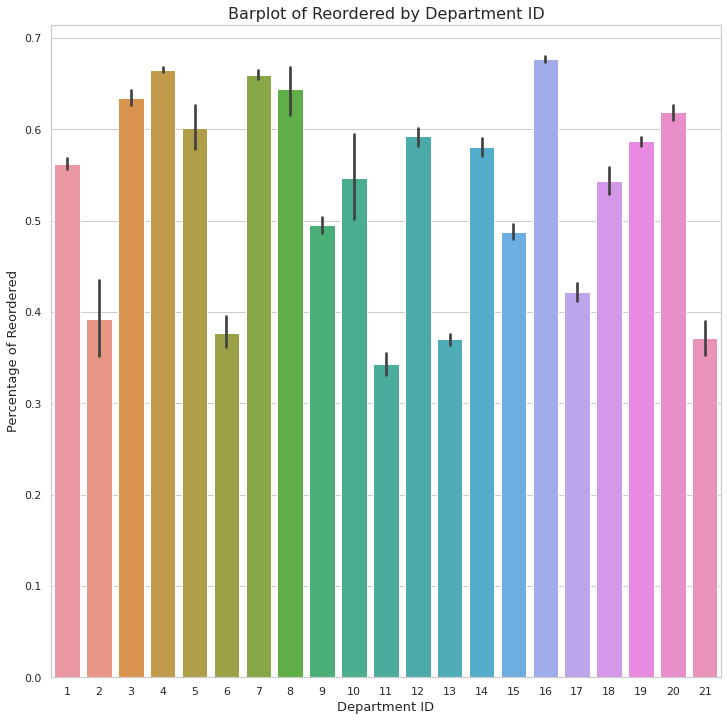
- 13개의 product에 대해 재주문율이 50% 이상이다.
- 위의 product_id 가 1, 3, 4, 5, 7, 8, 10, 12, 14, 16, 18, 19, 20 이 재구매율이 50% 이상이다.
| 1 | 3 | 4 | 5 | 7 | 8 | 10 | 12 | 14 | 16 | 18 | 19 | 20 |
|---|---|---|---|---|---|---|---|---|---|---|---|---|
| Frozen | Bakery | Produce | Alcohol | Beverages | Pets | Bulk | Meat and Seafood | Breakfast | Dairy eggs | Babies | Snacks | Deli |
# histplot of total number of order by department_id
plt.figure(figsize=(12,12))
dep_bar = sns.histplot(x='department_id',
bins=21,
data=train)
# xlab and ylab
dep_bar.set_xlabel('Department ID', fontsize=13)
dep_bar.set_ylabel('Total Number of Order', fontsize=13)
dep_bar.set_title('Histplot of Ordered by Department ID', fontsize=16)
plt.show()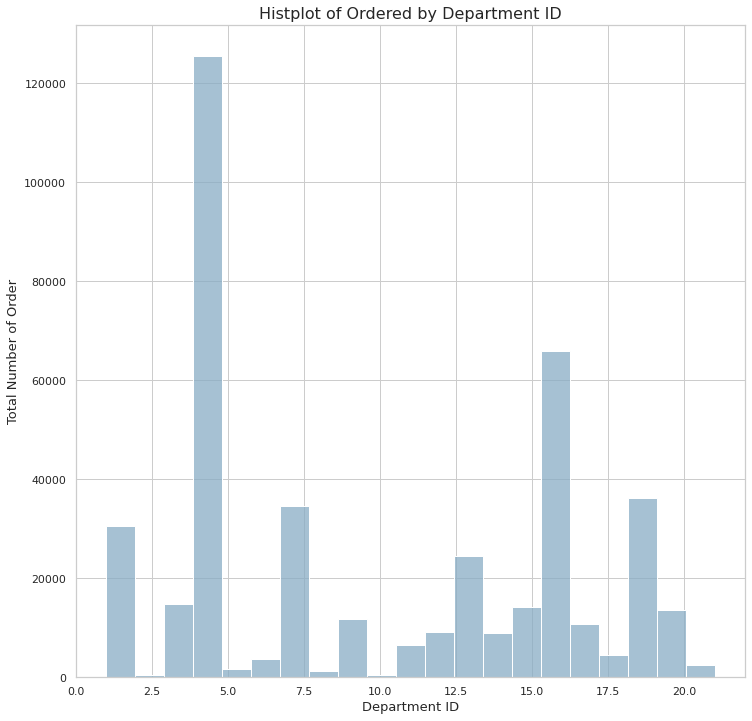
- 현재 전체에서 재주물율이 높은 품목은 21개 중에 13개 이다.
- 그러나 전체 판매합계를 보면 5개 품목(4, 16, 19, 7, 1 높은 순으로)의 주문량이 높다.
- 따라서 후에 4, 16, 19, 7, 1에 따른 EDA를 진행하는 것이 효율적으로 보인다.
| 4 | 16 | 19 | 7 | 1 |
|---|---|---|---|---|
| Produce | Dairy eggs | Snacks | Beverages | Frozen |
3.2 Product 에 따른 재주문
- 현재 Instacart 에서 원하는건 Product에 따른 재주문에 대한 정보를 얻는 것이다.
- 우선 전체 product의 주문과 재주문을 보자.
# product_id에 대해 오름차순으로 정렬
prod_sort = train['product_id']
prod_sort = prod_sort.sort_values()prod_sort
315587 1
116308 1
200210 1
97413 1
344722 1
...
219761 49683
350740 49683
83012 49686
316142 49688
181193 49688
Name: product_id, Length: 422286, dtype: int64# index 다시부여하기
prod_sort = prod_sort.reset_index()
prod_sort index product_id
0 315587 1
1 116308 1
2 200210 1
3 97413 1
4 344722 1
... ... ...
422281 219761 49683
422282 350740 49683
422283 83012 49686
422284 316142 49688
422285 181193 49688
422286 rows × 2 columns# drop the index column
prod_sort.drop('index', axis=1, inplace=True)
prod_sort.head()product_id
0 1
1 1
2 1
3 1
4 1prod_sort.plot()
plt.show()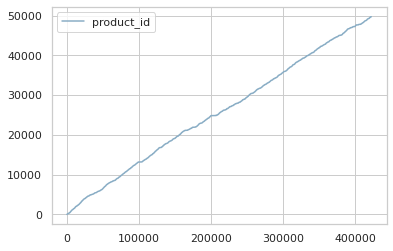
- 현재 plot이 보여주는 값은 product의 종류에 따라 linear형식으로 판매량이 높은것으로 보인다.
3.2.1 Department에 따른 Product 주문
- 현재 Product는 49,688개가 존재한다.
- 이때 상위 재품들만을 보기 보단 상위 5개의 Department에 따른 Product의 판매량과 재판매량을 보는것이 효율적일 것으로 판단된다.
# product_id convert int to object
train['product_id'] = train['product_id'].astype('object')
train.info()<class 'pandas.core.frame.DataFrame'>
RangeIndex: 422286 entries, 0 to 422285
Data columns (total 13 columns):
# Column Non-Null Count Dtype
--- ------ -------------- -----
0 order_id 422286 non-null int64
1 product_id 422286 non-null object
2 add_to_cart_order 422286 non-null int64
3 reordered 422286 non-null int64
4 aisle_id 422286 non-null int64
5 department_id 422286 non-null int64
6 department 422286 non-null object
7 aisle 422286 non-null object
8 order_number 422286 non-null int64
9 order_dow 422286 non-null int64
10 order_hour_of_day 422286 non-null int64
11 days_since_prior_order 422286 non-null int64
12 eval_set 422286 non-null object
dtypes: int64(9), object(4)
memory usage: 41.9+ MB# 상위 다섯개 Department의 전체주문에 대한 데이터 지정
dep4 = train[train['department_id']==4]
dep16 = train[train['department_id']==16]
dep19 = train[train['department_id']==19]
dep7 = train[train['department_id']==7]
dep1 = train[train['department_id']==1]# Department에 따른 product 정렬
dep4_prod = dep4.groupby('product_id').count()['reordered'].sort_values()
dep16_prod = dep16.groupby('product_id').count()['reordered'].sort_values()
dep19_prod = dep19.groupby('product_id').count()['reordered'].sort_values()
dep7_prod = dep7.groupby('product_id').count()['reordered'].sort_values()
dep1_prod = dep1.groupby('product_id').count()['reordered'].sort_values()
# Department에 따른 product 재주문 정렬
dep4_prod_re = dep4.groupby('product_id').sum()['reordered'].sort_values()
dep16_prod_re = dep16.groupby('product_id').sum()['reordered'].sort_values()
dep19_prod_re = dep19.groupby('product_id').sum()['reordered'].sort_values()
dep7_prod_re = dep7.groupby('product_id').sum()['reordered'].sort_values()
dep1_prod_re = dep1.groupby('product_id').sum()['reordered'].sort_values()# department_id 4의 product_id의 상위 10개에 대한 barplot
plt.subplot(1, 2, 1)
dep4_prod_plot = dep4_prod.tail(10).plot(kind='bar', figsize=(12, 12))
dep4_prod_plot.set_xlabel("Department 4's Top 10 Products", fontsize=13)
dep4_prod_plot.set_ylabel("Total Number of Orders", fontsize=13)
dep4_prod_plot.set_title("Number of Orders by Products", fontsize=15)
dep4_prod_plot.set_xticklabels(labels=dep4_prod.index, rotation=45)
# reordered 에 대한 Top 10
plt.subplot(1, 2, 2)
dep4_prod_re_plot = dep4_prod_re.tail(10).plot(kind='bar', figsize=(12, 12))
dep4_prod_re_plot.set_xlabel("Department 4's Top 10 Reordered Products", fontsize=13)
dep4_prod_re_plot.set_ylabel("Total Number of Orders", fontsize=13)
dep4_prod_re_plot.set_title("Number of Reorders by Products", fontsize=15)
dep4_prod_re_plot.set_xticklabels(labels=dep4_prod.index, rotation=45)
plt.show()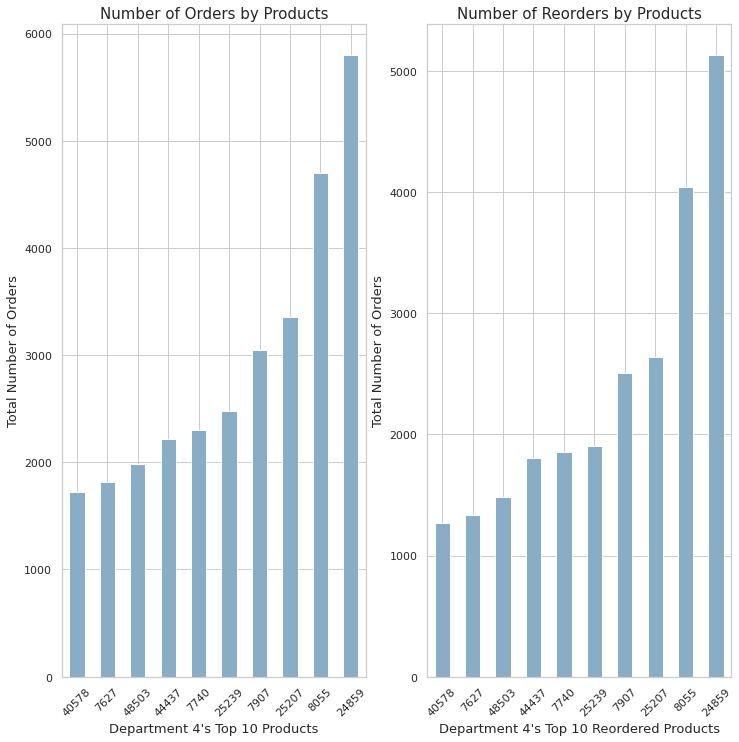
- 위의 10개의 재품에 대해 전체 주문량과 재주문량 순위가 매겨졌다.
- Department 4의 Top 10 주문과 재주문은 같은 순위를 가지고 있다.
# department_id 16의 product_id의 상위 10개에 대한 barplot
plt.subplot(1, 2, 1)
dep16_prod_plot = dep16_prod.tail(10).plot(kind='bar', figsize=(12, 12))
dep16_prod_plot.set_xlabel("Department 16's Top 10 Products", fontsize=13)
dep16_prod_plot.set_ylabel("Total Number of Orders", fontsize=13)
dep16_prod_plot.set_title("Number of Orders by Products", fontsize=15)
dep16_prod_plot.set_xticklabels(labels=dep16_prod.index, rotation=45)
# reordered 에 대한 Top 10
plt.subplot(1, 2, 2)
dep16_prod_re_plot = dep16_prod_re.tail(10).plot(kind='bar', figsize=(12, 12))
dep16_prod_re_plot.set_xlabel("Department 16's Top 10 Reordered Products", fontsize=13)
dep16_prod_re_plot.set_ylabel("Total Number of Reorders", fontsize=13)
dep16_prod_re_plot.set_title("Number of Reorders by Products", fontsize=15)
dep16_prod_re_plot.set_xticklabels(labels=dep16_prod.index, rotation=45)
plt.show()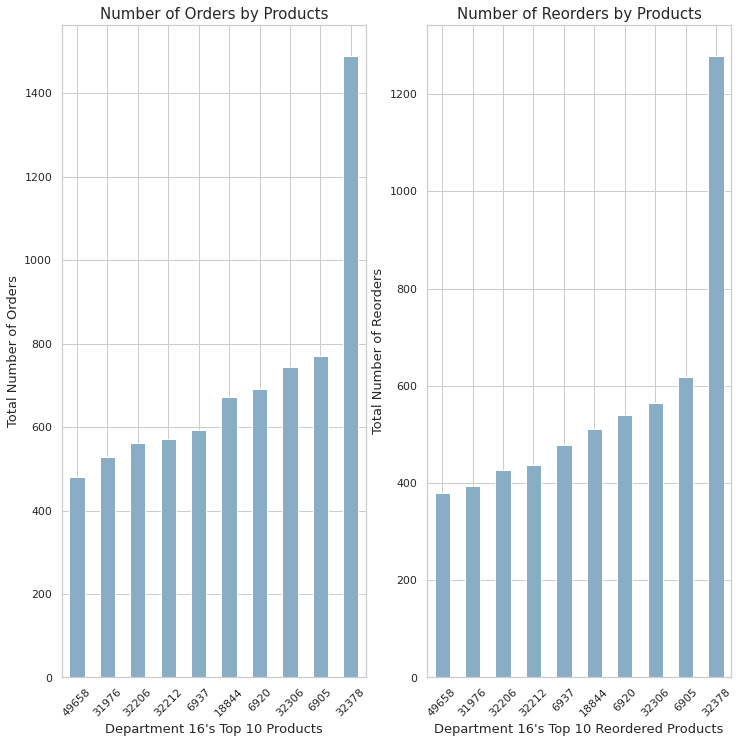
- 위의 10개의 재품에 대해 전체 주문량과 재주문량 순위가 매겨졌다.
- Department 16의 Top 10 주문과 재주문은 같은 순위를 가지고 있다.
# department_id 19의 product_id의 상위 10개에 대한 barplot
plt.subplot(1, 2, 1)
dep19_prod_plot = dep19_prod.tail(10).plot(kind='bar', figsize=(12, 12))
dep19_prod_plot.set_xlabel("Department 19's Top 10 Products", fontsize=13)
dep19_prod_plot.set_ylabel("Total Number of Orders", fontsize=13)
dep19_prod_plot.set_title("Number of Orders by Products", fontsize=15)
dep19_prod_plot.set_xticklabels(labels=dep19_prod.index, rotation=45)
# reordered 에 대한 Top 10
plt.subplot(1, 2, 2)
dep19_prod_re_plot = dep19_prod_re.tail(10).plot(kind='bar', figsize=(12, 12))
dep19_prod_re_plot.set_xlabel("Department 19's Top 10 Reordered Products", fontsize=13)
dep19_prod_re_plot.set_ylabel("Total Number of Reorders", fontsize=13)
dep19_prod_re_plot.set_title("Number of Reorders by Products", fontsize=15)
dep19_prod_re_plot.set_xticklabels(labels=dep19_prod.index, rotation=45)
plt.show()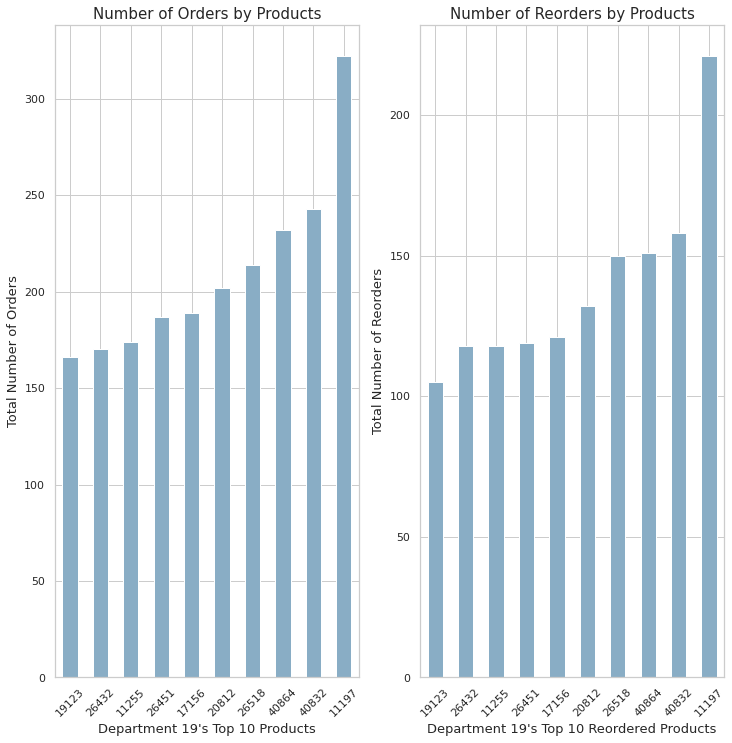
- 위의 10개의 재품에 대해 전체 주문량과 재주문량 순위가 매겨졌다.
- Department 19의 Top 10 주문과 재주문은 같은 순위를 가지고 있다.
# department_id 7의 product_id의 상위 10개에 대한 barplot
plt.subplot(1, 2, 1)
dep7_prod_plot = dep7_prod.tail(10).plot(kind='bar', figsize=(12, 12))
dep7_prod_plot.set_xlabel("Department 7's Top 10 Products", fontsize=13)
dep7_prod_plot.set_ylabel("Total Number of Orders", fontsize=13)
dep7_prod_plot.set_title("Number of Orders by Products", fontsize=15)
dep7_prod_plot.set_xticklabels(labels=dep7_prod.index, rotation=45)
# reordered 에 대한 Top 10
plt.subplot(1, 2, 2)
dep7_prod_re_plot = dep7_prod_re.tail(10).plot(kind='bar', figsize=(12, 12))
dep7_prod_re_plot.set_xlabel("Department 7's Top 10 Reordered Products", fontsize=13)
dep7_prod_re_plot.set_ylabel("Total Number of Reorders", fontsize=13)
dep7_prod_re_plot.set_title("Number of Reorders by Products", fontsize=15)
dep7_prod_re_plot.set_xticklabels(labels=dep7_prod.index, rotation=45)
plt.show()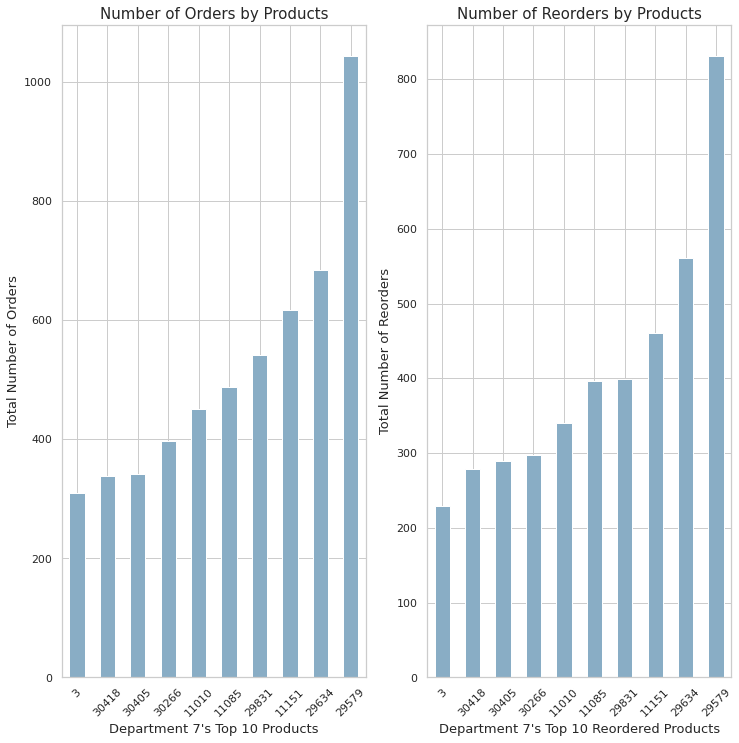
- 위의 10개의 재품에 대해 전체 주문량과 재주문량 순위가 매겨졌다.
- Department 7의 Top 10 주문과 재주문은 같은 순위를 가지고 있다.
# department_id 1의 product_id의 상위 10개에 대한 barplot
plt.subplot(1, 2, 1)
dep1_prod_plot = dep1_prod.tail(10).plot(kind='bar', figsize=(12, 12))
dep1_prod_plot.set_xlabel("Department 1's Top 10 Products", fontsize=13)
dep1_prod_plot.set_ylabel("Total Number of Orders", fontsize=13)
dep1_prod_plot.set_title("Number of Orders by Products", fontsize=15)
dep1_prod_plot.set_xticklabels(labels=dep1_prod.index, rotation=45)
# reordered 에 대한 Top 10
plt.subplot(1, 2, 2)
dep1_prod_re_plot = dep1_prod_re.tail(10).plot(kind='bar', figsize=(12, 12))
dep1_prod_re_plot.set_xlabel("Department 1's Top 10 Reordered Products", fontsize=13)
dep1_prod_re_plot.set_ylabel("Total Number of Reorders", fontsize=13)
dep1_prod_re_plot.set_title("Number of Reorders by Products", fontsize=15)
dep1_prod_re_plot.set_xticklabels(labels=dep1_prod.index, rotation=45)
plt.show()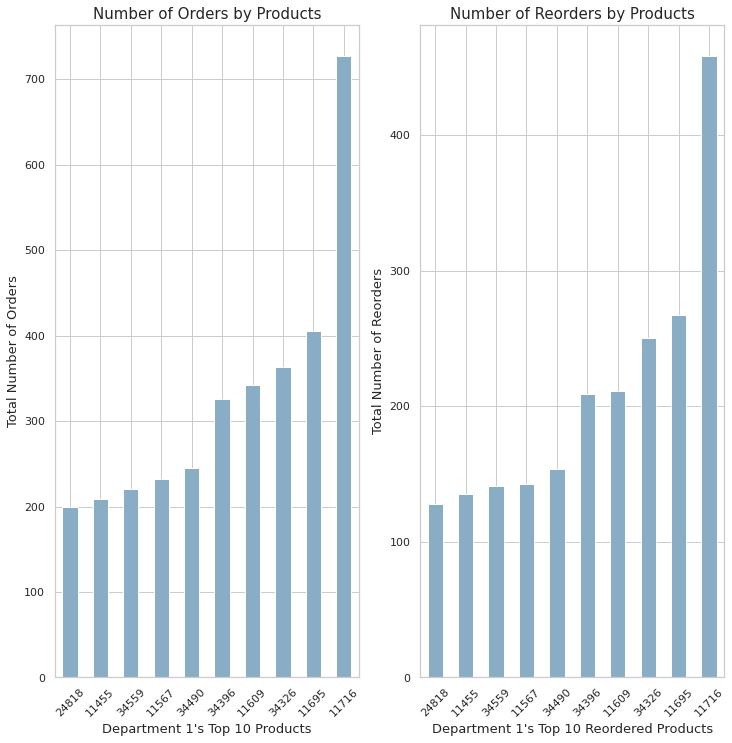
- 위의 10개의 재품에 대해 전체 주문량과 재주문량 순위가 매겨졌다.
- Department 1의 Top 10 주문과 재주문은 같은 순위를 가지고 있다.
3.2.2 Department와 Product에 대한 Insight
- 전체 주문과 재주문량이 Department 4 에서 가장 높게 나타났다.
- 절대적인 주문량이 높으면 재주문량 또한 높다.
- 상위 5개의 Department에 따른 재품들을 고객들에게 추천해주는 것이 효일적일 것으로 보인다.
3.3 days_since_prior_order 에 따른 재 구매율
- Instacart에는 monthly and annual 자동 주문기능이 있다.
- 웹사이트 상에 나와있는 홍보전략과 description을 보면 30일 단위로 재주문을 했을시 해택이 제공되는 것으로 보인다.
3.3.1 우선 일별로 재주문한 퍼센트에 대해 Barplot으로 살펴보다
# barplot of reordered by days_since_prior_order
plt.figure(figsize=(12,12))
dep_bar = sns.barplot(x='days_since_prior_order',
y='reordered',
data=train)
# xlab and ylab
dep_bar.set_xlabel('Reordered Days in 30', fontsize=13)
dep_bar.set_ylabel('Percentage of Reordered', fontsize=13)
dep_bar.set_title('Barplot of Reordered by Reordered Days in 30', fontsize=16)
plt.show()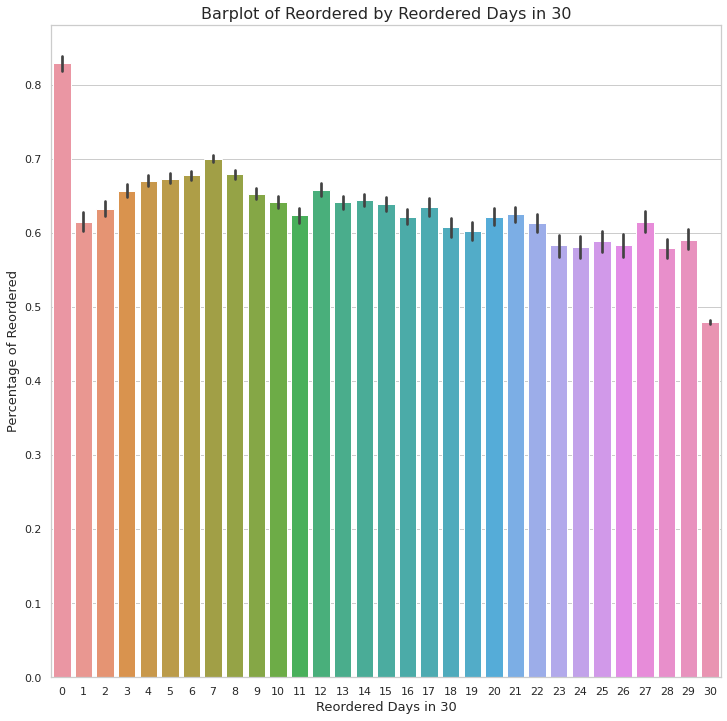
- 현재 비율로는 0일에 즉 제품을 주문한 날자에 재주문 하는 경우가 퍼센트 상으로 가장 높고 monthly order하는것이 가장 낮다.
- 이제 퍼센트가 아닌 카운트 상으로 어떻게 어떤 날자에 재주문량이 많은지 카운트 해보자
3.3.2 일별로 재주문한 건수에 대해 table 살펴보다
pd.crosstab(train['days_since_prior_order'], train['reordered'])
- 0일 즉 주문 당일 재주문은 퍼센트는 높지만 전체 카운트로 봤을때 높지가 않다.
- 반면에 30일 즉 monthly reorder는 퍼센트로는 낮지만 카운트로 봤을때 가장 높다.
- 따라서 monthly reorder가 Instacart에서 reorder 하는데 있어 가장 의미있는 수치를 보여준다.
- 다른 값들중 눈에 띄는 수치는 5~8일 이다.
- 5~8일 사이에 재주문 수치가 높은건 일주일 단위로 필요한 품목이 있는것으로 추측된다.
# 재주문에 대한 데이터 지정
reordered = train[train['reordered']==1]# histplot of total number of reordered by days_since_prior_order
plt.figure(figsize=(12,12))
dep_hist = sns.histplot(x='days_since_prior_order',
bins=30,
data=reordered)
# xlab and ylab
dep_hist.set_xlabel('Reordered Days in 30', fontsize=13)
dep_hist.set_ylabel('Total Number of Reordered', fontsize=13)
dep_hist.set_title('Barplot of Reordered by Reordered Days in 30', fontsize=16)
plt.show()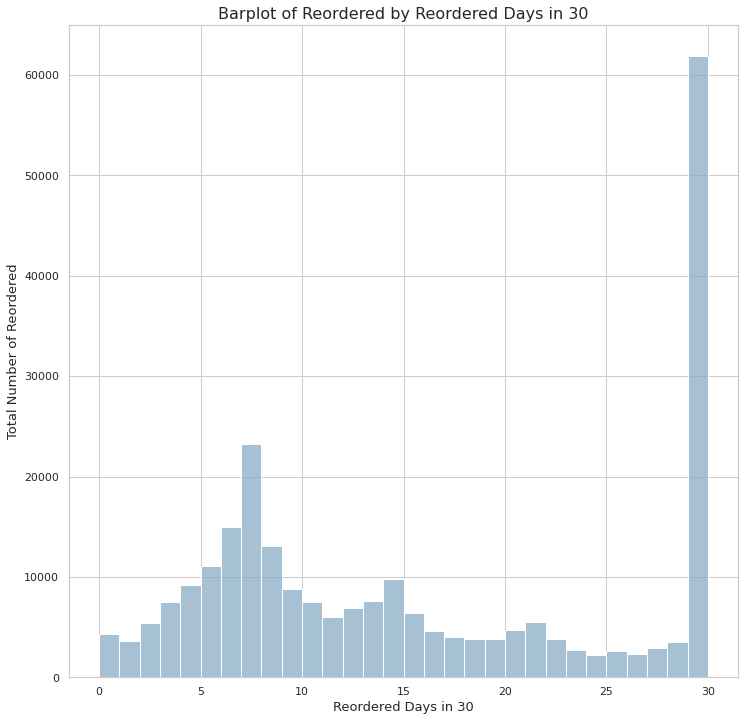
- 절대적으로 재주문량이 많은 날은 30일 이다.
- 그 다음 재주문량이 많은 날은 7일 이다.
3.3.3 재주문 날짜와 품목간의 상관관계
- 위의 결과들을 봤을때 일주일(5~8일) 단위로 주문 하는 품목과 한달 단위로 주문하는 품목이 있을것으로 보인다.
- 우선 일주일과 한달 단위와 전체 품목간의 관계를 보고 3.1에서 보여준 13개 품목이 재주문율이 높았는지 찾아보자.
# 일주일 과 한달에 대한 DataFrame 생성
fiveDays = train[(train['days_since_prior_order'] == 5) |
(train['days_since_prior_order'] == 6) |
(train['days_since_prior_order'] == 7) |
(train['days_since_prior_order'] == 8) |
(train['days_since_prior_order'] == 30)]# 5일에 대한 department 카운트
pd.crosstab([fiveDays['department_id'],fiveDays['reordered'] ], fiveDays['days_since_prior_order'], margins=True, margins_name="Total")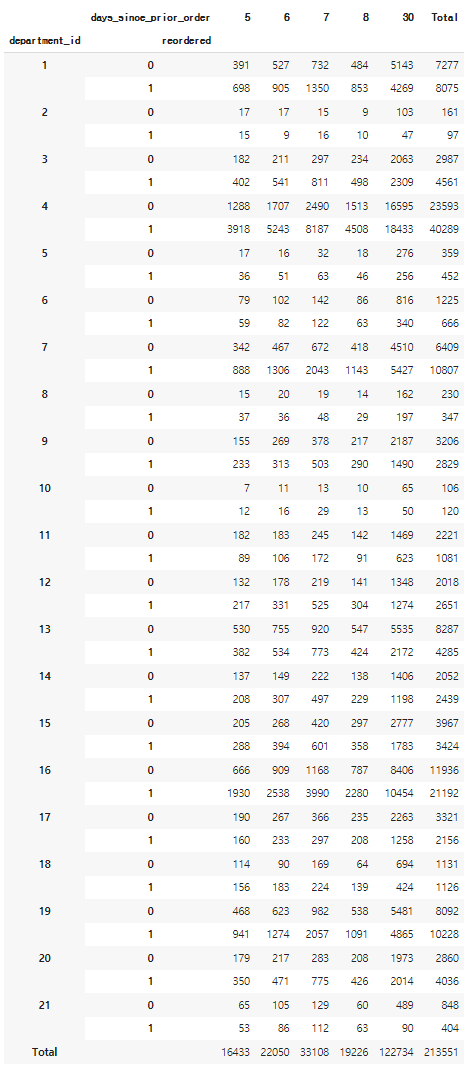
- 위에 카운트로 봤을시 조금 복잡하게 보인다.
- 위의 테이블을 퍼센트로 바꿔서 보자.
# 5일에 대한 department 퍼센트
table = pd.crosstab([fiveDays['department_id'],fiveDays['days_since_prior_order']], [fiveDays['reordered']],
normalize='index')pd.set_option('display.max_rows', None)
table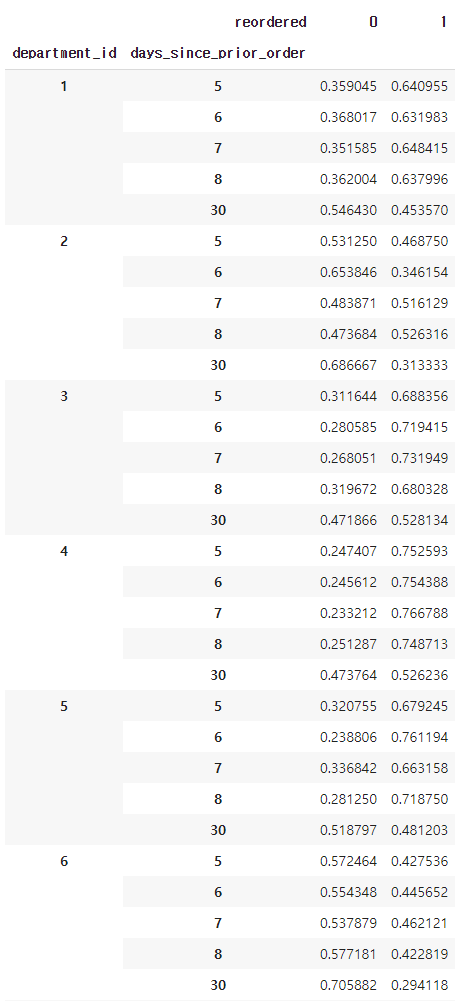
# 대표적으로 재구매가 많았던 날짜가 7일과 30일 임으로 두 날짜에 따른 재주문 율을 시각화 해보자
## 일주일
weekelyDays = train[(train['days_since_prior_order'] == 7) ]
weekelyTable = pd.crosstab([weekelyDays['department_id'],weekelyDays['days_since_prior_order']], [weekelyDays['reordered']],
normalize='index')
## 30일
monthlyDays = train[(train['days_since_prior_order'] == 30) ]
monthlyTable = pd.crosstab([monthlyDays['department_id'],monthlyDays['days_since_prior_order']], [monthlyDays['reordered']],
normalize='index')plt.figure(figsize=(20,10)) ## plot에 대한 matplotlib 생성
plt.subplot(1,2,1)
sns.heatmap(weekelyTable, vmin=0.2, vmax=0.8,
linewidths=1, cmap="BuPu", cbar=False)
plt.subplot(1,2,2)
sns.heatmap(monthlyTable, vmin=0.2, vmax=0.8,
linewidths=1, cmap="BuPu")
plt.show()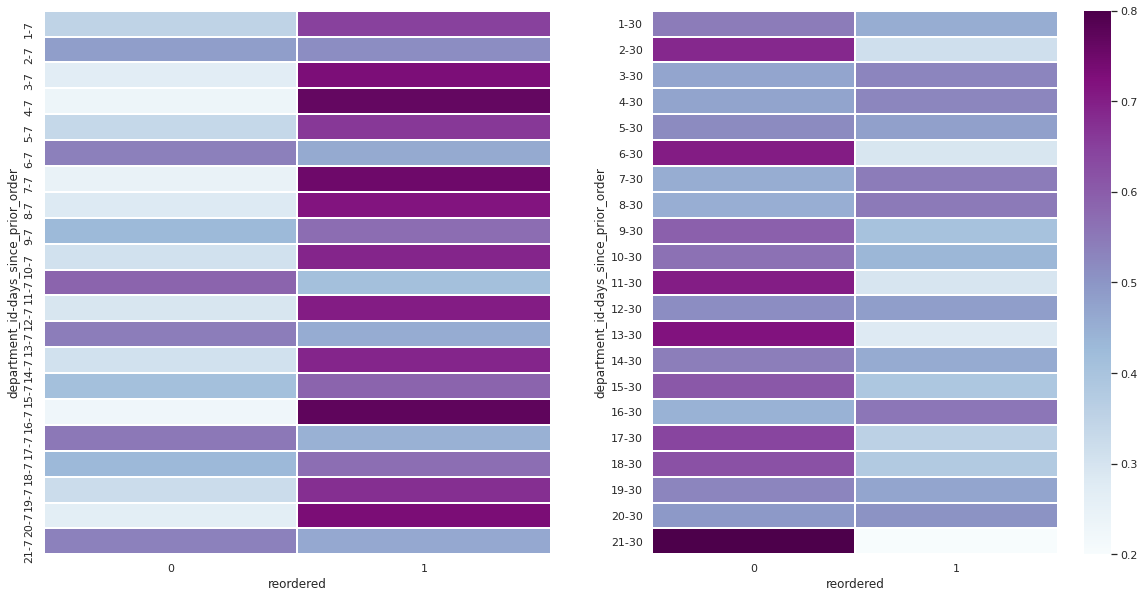
- 위의 좌측 테이블은 7일째에 재구매율에 대해 우측 테이블은 30일 째에 재구매율에 대해 보여준다.
- 짙은 보라색일 수록 재구매율이 높고 하늘샐일 수록 재구매율이 낮다.
- 대부분의 department에 대해 7일째에 재구매율이 높다.
위에 태이블을 통한 인사이트
- 위의 테이블을 통해 각 Department에 따른 요일별 제 판매율이 보인다.
- 전체 재 구매율 50% 이상이었던 13개의 제품군에 대해선 일주일과 monthly 재구매 율이 높은편이다.
- 새로운 점은 9번 과 15번 제품군 또한 재구매율이 50%이상 나온 것이다.
- 21개의 제품군에 대해서 15개의 제품군이 재구매율이 대략적으로 50% 이상이 된다.
- 파스타면과 캔제품(9번과 15번)의 경우 monthly reorder 대신에 일주일 내로 재구매율이 높다.
-다른 제품들의 경우에도 weekly reorder 가 monthly reorder보다 비율이 높게 나온다. - 따라서 Instacart에서 Monthly reorder 보다 Weekly reorder 상품을 만드는 것이 좋을것으로 보인다.
3.4 주문 요일(order_dow)에 따른 재주문
# histplot of total number of reordered by order_dow
plt.figure(figsize=(12,12))
dow_hist = sns.histplot(x='order_dow',
bins=30,
data=reordered)
# xlab and ylab
dow_hist.set_xlabel('Reordered dy Days of Week', fontsize=13)
dow_hist.set_ylabel('Total Number of Reordered', fontsize=13)
dow_hist.set_title('Histplot of Reordered by Days of Week', fontsize=16)
plt.show()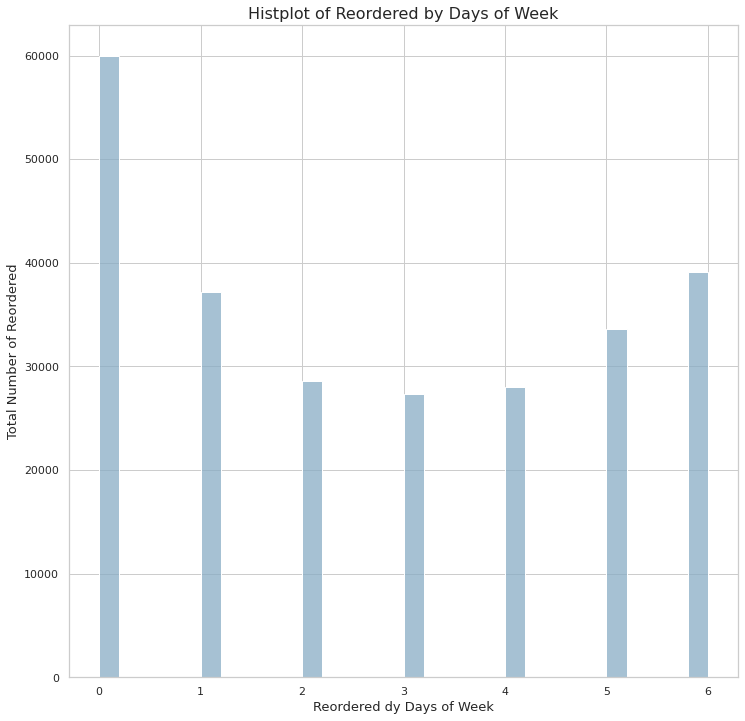
- 위의 테이블이 보여주는 값에 따르면 일주일 중 0, 1, 6에 가장 많은 소비가 이루어졌다.
- 현재 인덱스에 따른 요일 정보를 알 수 없기 때문에 우선 요일 0, 1, 6이라 칭하고 세개의 요일에 따른 재구매율을 확인하자.
3.4.1 전체 요일에 따른 재구매율
pd.crosstab(train['order_dow'], train['reordered'], normalize='index')reordered 0 1
order_dow
0 0.389994 0.610006
1 0.400654 0.599346
2 0.407971 0.592029
3 0.409911 0.590089
4 0.400812 0.599188
5 0.388554 0.611446
6 0.402141 0.597859
- 요일에 따른 재주문율은 크게 다르지 않다.
3.5 주문 시간(order_hour_of_day)에 따른 재주문량
# histplot of total number of order by order_hour_of_day
plt.figure(figsize=(12,12))
ohd_hist = sns.histplot(x='order_hour_of_day',
bins=24,
data=train)
# xlab and ylab
ohd_hist.set_xlabel('Order Hour of Day', fontsize=13)
ohd_hist.set_ylabel('Total Number of Order', fontsize=13)
ohd_hist.set_title('Histplot of Ordered by Order Hour of Day', fontsize=16)
plt.show()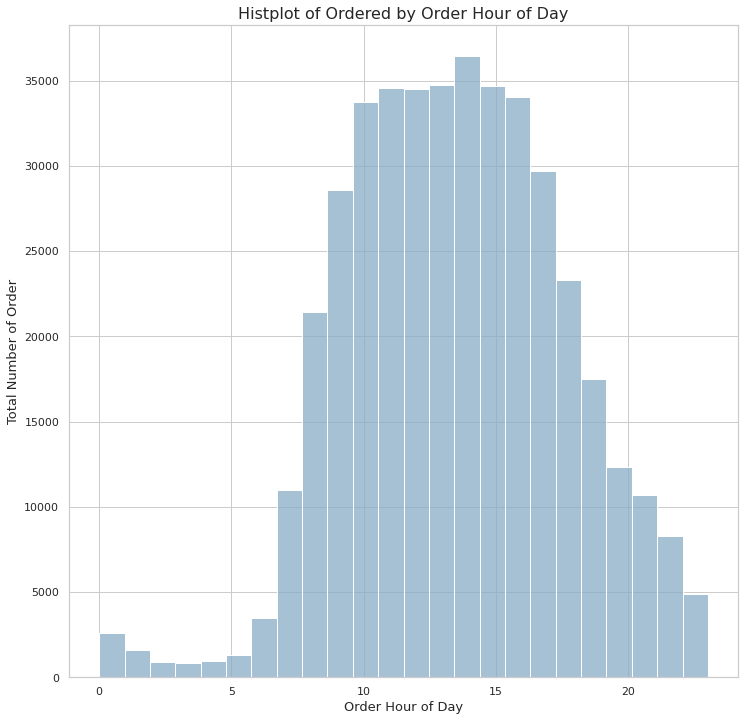
- Histplot에 따르면 10시 부터 17시 사이에 주문량이 가장 많다.
3.5.1 요일에 따른 시간별 주문량
day0 = train[train['order_dow']==0]
day1 = train[train['order_dow']==1]
day2 = train[train['order_dow']==2]
day3 = train[train['order_dow']==3]
day4 = train[train['order_dow']==4]
day5 = train[train['order_dow']==5]
day6 = train[train['order_dow']==6]plt.figure(figsize=(18, 5)) ## plot에 대한 matplotlib 생성
## day0
plt.subplot(2,4,1)
day0_hist = sns.histplot(x='order_hour_of_day',bins=24,data=day0)
##day1
plt.subplot(2,4,2)
day1_hist = sns.histplot(x='order_hour_of_day',bins=24,data=day1)
## day2
plt.subplot(2,4,3)
day2_hist = sns.histplot(x='order_hour_of_day',bins=24,data=day2)
## day3
plt.subplot(2,4,4)
day3_hist = sns.histplot(x='order_hour_of_day',bins=24,data=day3)
## day4
plt.subplot(2,4,5)
day4_hist = sns.histplot(x='order_hour_of_day',bins=24,data=day4)
## day5
plt.subplot(2,4,6)
day5_hist = sns.histplot(x='order_hour_of_day',bins=24,data=day5)
## day6
plt.subplot(2,4,7)
day6_hist = sns.histplot(x='order_hour_of_day',bins=24,data=day6)
plt.show()
- 각 요일에서 시간별 총 주문량은 차이가 없어보인다.
- 요일별 재주문량을 살펴보자
plt.figure(figsize=(18, 5)) ## plot에 대한 matplotlib 생성
## day0
plt.subplot(2,4,1)
day0_hist = sns.histplot(x='order_hour_of_day',bins=24,data=day0[day0['reordered']==1])
##day1
plt.subplot(2,4,2)
day1_hist = sns.histplot(x='order_hour_of_day',bins=24,data=day1[day1['reordered']==1])
## day2
plt.subplot(2,4,3)
day2_hist = sns.histplot(x='order_hour_of_day',bins=24,data=day2[day2['reordered']==1])
## day3
plt.subplot(2,4,4)
day3_hist = sns.histplot(x='order_hour_of_day',bins=24,data=day3[day3['reordered']==1])
## day4
plt.subplot(2,4,5)
day4_hist = sns.histplot(x='order_hour_of_day',bins=24,data=day4[day4['reordered']==1])
## day5
plt.subplot(2,4,6)
day5_hist = sns.histplot(x='order_hour_of_day',bins=24,data=day5[day5['reordered']==1])
## day6
plt.subplot(2,4,7)
day6_hist = sns.histplot(x='order_hour_of_day',bins=24,data=day6[day6['reordered']==1])
plt.show()
- 시간별 재주문량의 차이점도 크게 보이진 않는다.
- 즉 주문량이 많은 시간대엔 절대적인 재주문량 또한 절대적으로 높다.
요일과 시간에 따라 재주문량이 영향을 받지 않는다.
4. EDA의 결과
- 재주문이 가장 많은 Department는 아래의 표와 같다.
| 4 | 16 | 19 | 7 | 1 |
|---|---|---|---|---|
| Produce | Dairy eggs | Snacks | Beverages | Frozen |
-
절대적으로 거래량이 많은건 Produce department이다.
-
Monthly order 해택으로 인해 30일에 주문량과 재주문량이 가장 높은걸로 추측된다.
-
그러나 재구매율이 가장 높은건 일주일 단위로 이루어 진다.
-
Monthly order해택보다 Weekly order에 대한 해택을 만들어 주는게 더 효율적일 것으로 추측된다.
-
가장 주문량과 재주문량이 많은 시간대는 요일에 상관없이 10~17시 사이이다.
-
10~17시 사이에 팝업 광고나 특별세일 등을 넣으면 효과적인 마케팅이 될것으로 추측된다.

